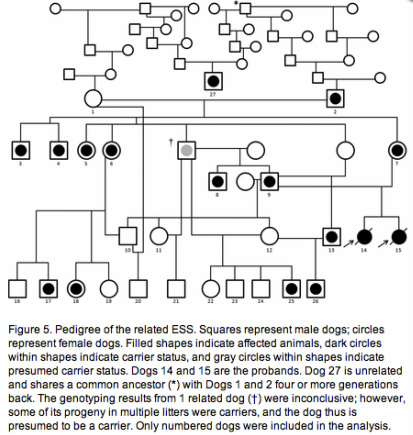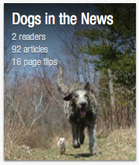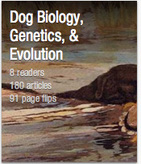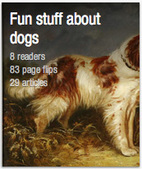
Background: Autosomal recessive hereditary nephropathy (ARHN) was diagnosed in 2 English Springer Spaniels (ESS), a breed not previously reported to be affected by hereditary nephropathy (HN).
Objective: To identify and characterize the genetic cause of ARHN in ESS.
This report documents the occurrence of ARHN in a family of ESS, a breed not previously reported to be afflicted with this disease. Affected ESS did not harbor the particular COL4A4 mutation that is known to cause ARHN in ECS; therefore a different mutation in COL4A4 or a mutation in COL4A3 was anticipated.
Two female ESS littermates were evaluated at the Texas A&M University College of Veterinary Medicine and Biomedical Sciences (TAMU-CVM) for renal disease that was first detected when the dogs were 7 months old. Each dog's renal disease was observed to progress to a near-terminal stage over the next 2–3 months, whereupon each dog was euthanized.
Mutation screening for C2806T in related and unrelated ESS identified 13 carriers out of 25 related dogs (Fig 5) and 1 carrier among 35 unrelated dogs. Detailed pedigree analysis identified a common ancestor for the unrelated carrier (Dog 27) and the 2 founders of the family (dogs 1 and 2) 4 generations back. The common ancestor indicates that the mutation is not de novo within the nuclear family in Figure 5, and that additional carriers within the breed are likely. Given the small number of unrelated dogs tested in this study, it is not possible to predict the frequency of the mutant allele in the ESS population. Therefore, a population study to estimate the prevalence of carriers within the breed is warranted.
Download pdf.
Nowend et al 2012 Characterization of the Genetic Basis for Autosomal Recessive Hereditary Nephropathy in the English Springer Spaniel. J Vet Int Med 26: 294-301.
Objective: To identify and characterize the genetic cause of ARHN in ESS.
This report documents the occurrence of ARHN in a family of ESS, a breed not previously reported to be afflicted with this disease. Affected ESS did not harbor the particular COL4A4 mutation that is known to cause ARHN in ECS; therefore a different mutation in COL4A4 or a mutation in COL4A3 was anticipated.
Two female ESS littermates were evaluated at the Texas A&M University College of Veterinary Medicine and Biomedical Sciences (TAMU-CVM) for renal disease that was first detected when the dogs were 7 months old. Each dog's renal disease was observed to progress to a near-terminal stage over the next 2–3 months, whereupon each dog was euthanized.
Mutation screening for C2806T in related and unrelated ESS identified 13 carriers out of 25 related dogs (Fig 5) and 1 carrier among 35 unrelated dogs. Detailed pedigree analysis identified a common ancestor for the unrelated carrier (Dog 27) and the 2 founders of the family (dogs 1 and 2) 4 generations back. The common ancestor indicates that the mutation is not de novo within the nuclear family in Figure 5, and that additional carriers within the breed are likely. Given the small number of unrelated dogs tested in this study, it is not possible to predict the frequency of the mutant allele in the ESS population. Therefore, a population study to estimate the prevalence of carriers within the breed is warranted.
Download pdf.
Nowend et al 2012 Characterization of the Genetic Basis for Autosomal Recessive Hereditary Nephropathy in the English Springer Spaniel. J Vet Int Med 26: 294-301.
 RSS Feed
RSS Feed





